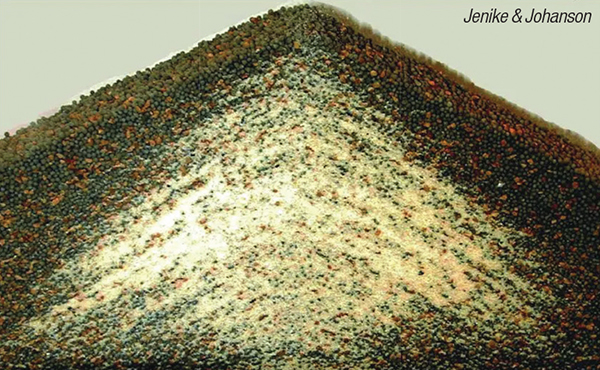In solids-handling, blending (combining two or more materials to achieve a combined product) and segregation (the separation of particles into distinct zones according to particle size, shape, density or other physical attributes) are competing processes. This one-page reference outlines common mechanisms by which these processes occur.
Random and ordered blends
A random blend occurs when the blend components do not adhere or bind with each other during motion through the blend vessel [1]. Particles that form random blends can be easy to blend, because they move easily relative to one another, but they also can readily separate from each other, collecting in zones of similar particles when forces, such as gravity, airflow or vibration, act on the blend.
In most dry-blending applications, particles have some tendency to interact with one another via chemical, molecular, physical or other means such that individual particles can agglomerate, coat or bond to one another [2]. When particle interaction occurs, the blend is referred to as an ordered or structured blend. In most industrial processes, the reality is somewhere between the two blend types. Some particles of the blend may have very little tendency to interact while other blend components may have significant interaction.
Blending mechanisms
Three primary blending mechanisms are convection, diffusion and shear.
Convection. Convection is the transfer of a collection of particles from one location to another. This can occur as a result of material cascading in a tumble blender, material moving against the blade of a ribbon or paddle blender or as a result of gas-pressure pulses in a pneumatic blender.
Diffusion. Diffusion is the random redistribution of particles that occurs as a result of increased particle mobility. Increased mobility typically occurs when the bulk density of the material is decreased sufficiently to allow individual particles to move relative to one another. Fluidization in fluidized-bed reactors or granulators results in diffusion. Mechanical blenders move collections of particles by convection, but when the speed of the agitator is sufficient to locally fluidize material, diffusion occurs.
Shear. Shear occurs in a flowing granular solid as a result of a velocity gradient, and can develop as either a discontinuous shear (for instance, a shear or slip plane) or as a continuous gradient of velocity. In either case, there can be some overlap in what could be called shear and what might be characterized as convection. The important difference, as it applies to solids blending, is in the intensity. Shear planes that develop in gravity blending or in a tumble blender predominantly result in mixing by convection. Shear in a high-speed mixer is more effective in breaking up agglomerates of fine powders and distributing small-particle-size material with high surface activity.
Segregation mechanisms
Segregation can be driven by factors including gravity, electrostatic forces, fluid-drag forces and elastic forces. Common segregation mechanisms are sifting, fluidization and dusting.
Sifting. The most prevalent type of segregation is sifting, which results in separation by particle size. Sifting segregation is the most common means for particles to separate. It occurs when small, fine particles move through large, coarser particles (Figure 1). Sifting segregation occurs to some degree in most bulk-solids operations. Sifting will occur in mixtures of different-sized particles when particles are sufficiently large that surface forces are weak relative to gravity (usually larger than 100 μm), when particles have mobility relative to one another and when there is some mechanism to allow particles to move relative to one another [2]. Collections of different size particles will not spontaneously segregate when at rest, but will often readily segregate when allowed to move. For sifting to occur, material must be free-flowing, have a range of particle sizes, have some fairly large (>100 mesh) particles, and have some means of interparticle motion [3].

FIGURE 1. Sifting segregation, where particles of varying sizes separate due to gravitational forces, is particularly common in processes that involve piling materials or filling bins
Fluidization. This type of segregation results when finer, lighter particles rise to the top surface of a fluidized blend of powder, while the larger, heavier particles concentrate at the bottom of the bed. The fluidizing air entrains the fines and carries them to the top surface. This mechanism generally only occurs with powders with an average particle size smaller than 100µm [1]. Fluidization segregation is likely to occur when fine materials are pneumatically conveyed, when they are filled or discharged at high rates, or if gas counter-flow occurs. The more cohesive the material, the less likely it will segregate by this mechanism.
Dusting. Particle entrainment or dusting segregation occurs when fine particles in a blend are carried by air currents (such as during transfer of a blend into a container) and then settle preferentially at the container walls. This mechanism requires four conditions: difference in particle sizes; relatively large particles (average size greater than 100µm); free-flowing material; and inter-particle motion.
References
1. Maynard, E., Blender Selection and Avoidance of Post-Blender Segregation, Chem. Eng., May 2008.
2. Troxel, T.G., Blending, Sampling and Segregation, Chem. Eng., October 2012, pp. 41–46.
3. Marinelli, J., Will Mass Flow Solve All Your Segregation Problems?, Chem. Eng., April 2006.